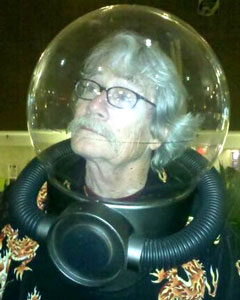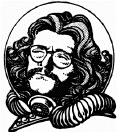Science Fiction and
the Theater of the Mind

by David Ossman
Science fiction written and produced for the theatre of the mind began in the earliest years of theatre on the air. “Buck Rogers in the 25th Century” debuted in 1932, the paleolithic era of the radio medium.
At first, SF radio meant comic-strip heros in 15-minute daily doses for kids who liked to use their imaginations. Then writer Howard Koch, collaborating with H. G. Wells, Orson Welles and the Mercury Theatre production team lit all of America’s imaginations on fire when the Martians invaded New Jersey for Halloween 1938. The relentless, ruthless, diobolical Martians were out to conquer the World.
Always limited by the restrictions of the AM radio, writers and producers of SF nevertheless found ways of using the medium as it developed both in quality of sound reproduction and as an art form in its own right.
After “The War of the Worlds” and World War Two, radio and the movies returned from their propaganda mission and writers began to reflect on the Future once more. Pulp SF had been around since at least 1897, when the Wells novel was serially published in Cosmopolitan. In the 1940s the genre spawned “slicker” pulps, writers of great talent, a “noir” post-war undercurrent of fear, and, in 1950, the film, “Destination Moon.”
Dimension X and X-Minus One
“Destination Moon” was recreated on radio in June 1950, even as the movie played to packed houses. It appeared as the twelfth episode of “Dimension X,” the first radio series to present “serious” SF – the stories and novels of Bradbury, Heinlein, Asimov and Vonnegut. Running for a total of fifty programs, “Dimension X” was a unique vehicle for the theatre of the mind, thrilling kids of my generation. At the very end of the Golden radio era, “X-Minus One” appeared to reprise the earlier “Dimension X” scripts and create new ones for 125 programs, finally leaving the air early in 1958.
In the 1960s, science fiction was on its way to being science fact. Radio coverage was of the reality of space exploration. A new generation of fiction writers made use of each new discovery about the Solar System and Outer Space and the key experience for the mind as well as the eye was Stanley Kubrick’s 1968 feature, “2001: A Space Odyssey,” followed soon after by American astronauts leaving footsteps on the Moon.
The 1970s
It was time to use the audio medium to look into the future once again, and the opportunity was taken by The Firesign Theatre to transport its fans to The Future Fair, which introduced a new generation to the fast-arriving Digital Age. “I Think We’re All Bozos on This Bus” (1971) took its listeners into the Hard Disk of Darkness, where Dr. Memory lives and controls clones and Presidents alike.
Each of the Firesign foursome undertook a comic vision of the Future in three LP’s which followed in 1973, including my take on “How Time Flys,” which transformed the comic-book radio hero Mark Time into a returning astronaut, scorned by a public who prefers simulation to reality and where reality itself becomes entertainment-for-profit.
The watershed production in “contemporary” science fiction audio was “The Hitchhiker’s Guide to the Galaxy,” with Goon Show-quality humor by Douglas Adams creatively produced by Geoffrey Perkins for the BBC. “Hitchhiker” hit public radio in the US in 1980, just as the National Endowment for the Arts was making room in its madate for more “radio drama.” The series clearly demonstrated some new possibilities for writers and producers alike.
The 1980s
Independent radio producers, some of whom had been creating stereo, multi-channel audio theatre and sound design for decades, began creating some of their best work, including Tom Lopez’ “Ruby,” which debuted in 1982, work by Chicago’s Yuri “El Fiendo” Rasovsky, Tom Voegeli’s “Star Wars” productions for NPR, and in 1988, to celebrate the 50th Anniversary of Welles’ “War of the Worlds,” the first all-digital audio theatre production, informed by the skills of Oscar®- winner Randy Thom.
The 90s and the New Millennium
In the last fifteen years, a host of new producers have been attracted to audio, as the ability to create digitally anything the mind can imagine has become easily affordable. Most release their productions on CD, as even public radio has lost interest in many of the audio arts.
The Mark Time Awards have helped encourage, promote and honor thirty-five independent productions in the first eight years of their presentation. The American Society for Science Fiction Audio has also honored four producers with Grand Master Awards, and has established a Hall of Fame which presently includes over twenty broadcasts, productions and series that highlight the history of science fiction in the audio and radio media. Research continues on a catalogue of available material.
Science fiction is perhaps the most important audio theatre genre in the 21st century and if one includes the related genres of horror and fantasy, these works of creative imagination, technical prowess and infinite possibilities are what the most entertaining artists in this field have to offer.
